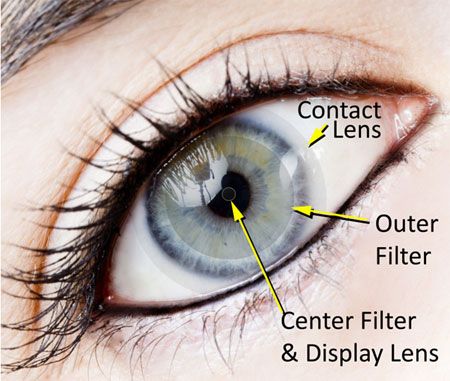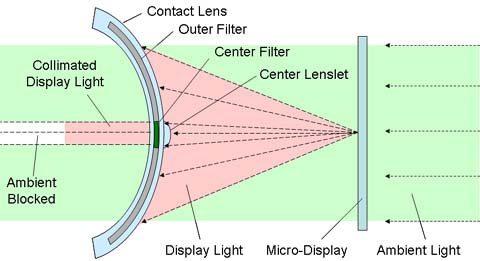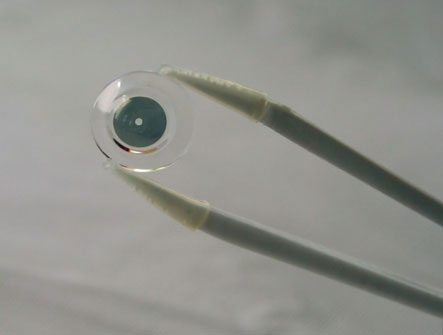 Innovega is a Washington-based company that’s working on contact lenses that use filters to allow the eye to simultaneously focus on objects at varying distances. The development could help make augmented reality a practicality by greatly reducing the bulk of HMD and augmented reality displays. Instead of using bulky optics to focus the light appropriately before it enters the eye, Innovega’s ‘iOptik‘ solution uses a contact lens with a polarized filter to send the augmented display overlay to a discrete part of the eye without obscuring the real scene behind the display. This technique allows the eye to simultaneously focus on the augmented information and the real world at the same time. Innovega explains how the iOptik solution works in this demonstration video:
Innovega is a Washington-based company that’s working on contact lenses that use filters to allow the eye to simultaneously focus on objects at varying distances. The development could help make augmented reality a practicality by greatly reducing the bulk of HMD and augmented reality displays. Instead of using bulky optics to focus the light appropriately before it enters the eye, Innovega’s ‘iOptik‘ solution uses a contact lens with a polarized filter to send the augmented display overlay to a discrete part of the eye without obscuring the real scene behind the display. This technique allows the eye to simultaneously focus on the augmented information and the real world at the same time. Innovega explains how the iOptik solution works in this demonstration video:
[youtube=http://www.youtube.com/watch?v=khWE-GYccRg]
Here’s a diagram from Innovega which helps visualize exactly how the simultaneous focusing is achieved:
It’s important to note that the iOptik contact itself is not a display. The contact is merely a way to enable multi-focual functionality for the eye, while the actual augmented reality display would be provided by a glasses-based system. The iOptik solution makes light-weight glasses-sized augmented reality displays and wearable computing applications, like Google Glass, a possibility. It could also greatly reduce the bulk of fully immersive HMDs for virtual reality use. One neat tidbit is that the system is that it can be combined with a traditional vision-correcting contact prescription.
Such a setup could easily be used to project a HUD directly onto a pilot’s eyewear instead of using a much larger and less flexible glass-based HUD projection system. For a foot soldier, it could replace heavy and intrusive helmet-mounted eyewear. Given such applications, it’s not surprising that DARPA (Defense Advanced Research Projects Agency) has funded Innovega’s iOptik project. Here’s what DARPA has to say about the project:
Developed as part of DARPA’s Soldier Centric Imaging via Computational Cameras (SCENICC) program, SCENICC’s objective is to eliminate the ISR [Intelligence, Surveillance and Reconnaissance] capability gap that exists at the individual Soldier level. The program seeks to develop novel computational imaging capabilities and explore joint design of hardware and software that give warfighters access to systems that greatly enhance their awareness, security and survivability.
Innovega has made it clear, however, that this technology will not be exclusive to the military realm. Although it doesn’t seem at they will develop and market their own augmented reality display, their website is filled with references of the possibility of consumer-oriented high field-of-view devices that could be made with the iOptik solution. The end-game for this project, according to the company, is to license the technology for use by other companies seeking to create AR displays. According to Steve Willey, CEO and director of Innovega, the iOptik technology could be ready for public consumption by 2014.
Thanks to Kaan for tipping this story!








